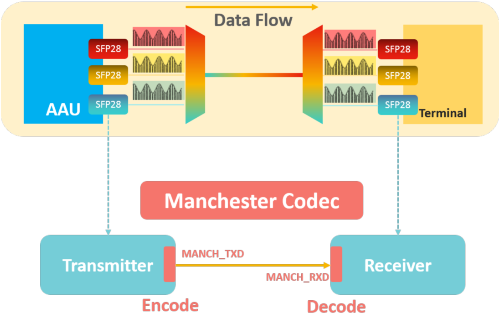Microcontrollers Optical module solutions M0xxG MCUs(ARM Cortex M0 )
페이지 정보

본문

2019 was the beginning of the 5G development cycle in Taiwan; with the development of 5G, the internet will become the future trend, and smart homes, smart factories, and even smart cities can be realized because of it. Therefore, 5G applications must be supported for infrastructure to networked devices; telecom operators also started planning 5G frequency bands and related transmission specifications for the coming of the 5G era.
The optical module is an indispensable part of 5G networks; therefore, Nuvoton provided a set of complete optical module solutions – the NuMicro M030G/ M031G series; the M031G series is also the world’s first hardware modulation MCU. Whether it is an application in the data communication field to the telecommunication field or the universal optical modules used for existing optical transmission modules to the modulated optical modules used for the 5G fronthaul wavelength division multiplexing (WDM) scenarios, it can support all their application needs. Nuvoton’s NuMicro M030G series is applicable for universal optical modules, and it is the world’s first hardware modulation MCU; the NuMicro M031G series, was designed exclusively for modulated optical modules.

Figure 1 Recommended models for the Nuvoton optical module MCU
Features of the NuMicro M030G/ M031G series
- Hardware Manchester Transcoder (M031G series): Modulates and demodulates low-frequency perturbation signals
- DAC supports the automatic data generation function (M031G series): Able to generate 32 points of a smooth sine wave at 500 kHz for the output of the modulation function
- Built-in temperature sensor: Accuracy from 0 °C to 70 °C is ± 1.6 °C; the accuracy from -40 °C to 105 °C is ± 2 °C
- Small package: QFN24 3x3 mm; QFN33 4x4 mm
- I²C: Supports 1 MHz of slave mode and will not hold SCL, has I2C Bootloader preprogrammed upon shipment

Figure 2 Features of the NuMicro M030G/ M031G series
MCU for universal optical modules

Figure 3 Block diagram for the NuMicro M030G series
The two ends of the optical module are connected to the electric port and optical port respectively, and I2C is used at the electric port to communicate with the host computer. The function of the optical module is to convert the optical or electric signal to an electric or optical signal and transmit it. Therefore, the optical module is composed of the two parts transmitter optical subassembly (TOSA) and the receiver optical subassembly (ROSA). The optical power is affected by temperature changes; therefore, the status of the optical module must be monitored, and reference voltage must be provided for adjustments. Therefore, the MCU must be equipped with the ability to measure temperatures – temperature sensor, and the ability to measure and adjust voltages – ADC and DAC. In addition, the size of the optical module is also extremely small. Therefore, the MCU must also have a small package. It is also because of its compact size that the optical module has no room reserved for other interfaces besides the I2C interface.
Nuvoton’s NuMicro M030G/ M031G series were designed specifically for optical modules. Besides having sufficient DAC and ADC, they both have temperature sensors built-in and provide the QFN24 and QFN33 small package selections. They are also equipped with two sets of I²C interfaces and have the I2C Bootloader preprogrammed by default, fully meeting the needs of universal optical modules.

Figure 4 Dimensions and speed of the optical module
MCU for a modulated optical module

Figure 5 Block diagram of the NuMicro M031G series
Nuvoton released the world’s first hardware modulation MCU, the NuMicro M031G series. This series is equipped with the Hardware Manchester Transcoder, able to quickly modulate and demodulate Manchester codes to use as modulating signals. Based on the needs of different telecom operators and equipment vendors, the modulating signal can be further divided into amplitude modulation (AM) and frequency modulation (FM) (multi-carrier modulation); no matter which mode it is, Nuvoton’s NuMicro M031G series can support them both.
The modulation signal is dependent on the original business signal and superimposes a small amplitude signal. That’s why it is also called a low-frequency perturbation signal. This signal must be transmitted with Manchester code to use changes in the signal to maintain synchronization between transmission and reception. In order to generate and receive Manchester codes, the optical module must be equipped with the Manchester transcoder; this is the biggest difference between modulated optical modules and universal optical modules.

Figure 6 Built-in Manchester transcoder of the optical module
Nuvoton’s NuMicro M031G series not only is equipped with the hardware Manchester transcoder that supports CRC, and can be used to modulate and demodulate low-frequency perturbation signals, it is also equipped with another set of DAC that supports the function to generate data automatically, able to generate sine waves for frequency modulation to use. Nuvoton tested that smooth sine wave modulation signals can be generated under 500 kHz frequency.

Figure 7 Generation method of sine wave modulation signals

Figure 8 Actual test of MANCH_TX generated by DAC0
Nuvoton’s NuMicro M030G/ M031G series provides complete solutions for optical modules, and the M031G series is also the world’s first hardware modulation module; therefore, whether it is for universal optical module applications or modulation function optical modules, their needs can be met completely.

Figure 9 Features of the NuMicro M030G/ M031G series
자세한 내용은 아래 링크를 참조해주세요.
*문의
TEL. 031-479-1828~9
E-Mail: alex_sung@picoinc.co.kr



